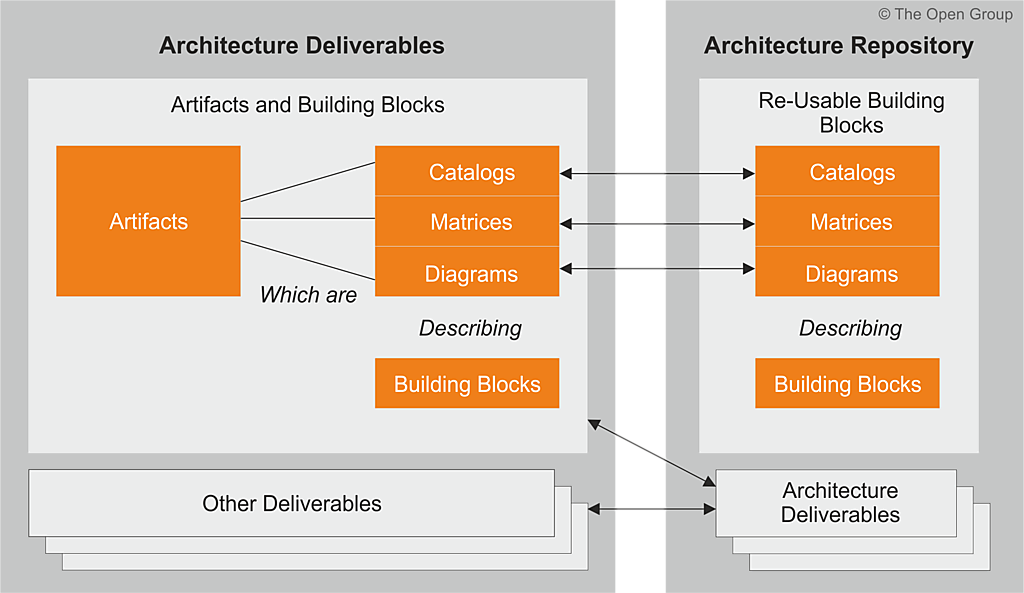
| You are here: | ||
| <<< Previous | Home | Next >>> |
For the purposes of the TOGAF standard, the core concepts provided in this chapter apply.
The TOGAF standard is an architecture framework. It provides the methods and tools for assisting in the acceptance, production, use, and maintenance of an Enterprise Architecture. It is based on an iterative process model supported by best practices and a re-usable set of existing architecture assets.
ISO/IEC/IEEE 42010:2011 defines "architecture" as:
"The fundamental concepts or properties of a system in its environment embodied in its elements, relationships, and in the principles of its design and evolution."
The TOGAF standard embraces but does not strictly adhere to ISO/IEC/IEEE 42010:2011 terminology. In addition to the ISO/IEC/IEEE 42010:2011 definition of "architecture", the TOGAF standard defines a second meaning depending upon the context:
"The structure of components, their inter-relationships, and the principles and guidelines governing their design and evolution over time."
The TOGAF standard considers the enterprise as a system and endeavors to strike a balance between promoting the concepts and terminology drawn from relevant standards, and commonly accepted terminology that is familiar to the majority of the TOGAF readership. For more on terminology, refer to 3. Definitions and Part IV, 31. Architectural Artifacts .
There are four architecture domains that are commonly accepted as subsets of an overall Enterprise Architecture, all of which the TOGAF standard is designed to support:
The TOGAF Architecture Development Method (ADM) provides a tested and repeatable process for developing architectures. The ADM includes establishing an architecture framework, developing architecture content, transitioning, and governing the realization of architectures.
All of these activities are carried out within an iterative cycle of continuous architecture definition and realization that allows organizations to transform their enterprises in a controlled manner in response to business goals and opportunities.
Phases within the ADM are as follows:
It includes information about defining the scope of the architecture development initiative, identifying the stakeholders, creating the Architecture Vision, and obtaining approval to proceed with the architecture development.
Architects executing the ADM will produce a number of outputs as a result of their efforts, such as process flows, architectural requirements, project plans, project compliance assessments, etc. The TOGAF Architecture Content Framework (see Part IV, 29. Introduction to Part IV) provides a structural model for architectural content that allows major work products to be consistently defined, structured, and presented.
The Architecture Content Framework uses the following three categories to describe the type of architectural work product within the context of use:
Deliverables represent the output of projects and those deliverables that are in documentation form will typically be archived at completion of a project, or transitioned into an Architecture Repository as a reference model, standard, or snapshot of the Architecture Landscape at a point in time.
Artifacts are generally classified as catalogs (lists of things), matrices (showing relationships between things), and diagrams (pictures of things). Examples include a requirements catalog, business interaction matrix, and a use-case diagram. An architectural deliverable may contain many artifacts and artifacts will form the content of the Architecture Repository.
Building blocks can be defined at various levels of detail, depending on what stage of architecture development has been reached. For instance, at an early stage, a building block can simply consist of a name or an outline description. Later on, a building block may be decomposed into multiple supporting building blocks and may be accompanied by a full specification. Building blocks can relate to "architectures" or "solutions".
The relationships between deliverables, artifacts, and building blocks are shown in Figure 2-1 .

For example, an Architecture Definition Document is a deliverable that documents an Architecture Description. This document will contain a number of complementary artifacts that are views of the building blocks relevant to the architecture. For example, a process flow diagram (an artifact) may be created to describe the target call handling process (a building block). This artifact may also describe other building blocks, such as the actors involved in the process (e.g., a Customer Services Representative). An example of the relationships between deliverables, artifacts, and building blocks is illustrated in Figure 2-2 .
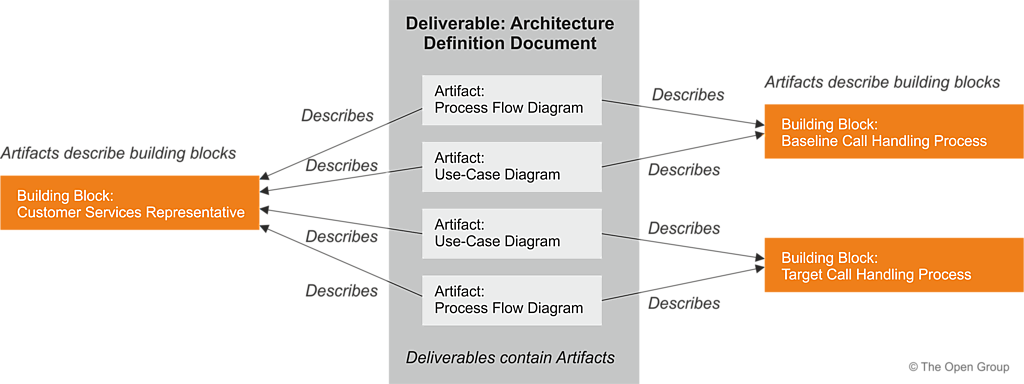
The TOGAF standard includes the concept of the Enterprise Continuum, which sets the broader context for an architect and explains how generic solutions can be leveraged and specialized in order to support the requirements of an individual organization. The Enterprise Continuum is a view of the Architecture Repository that provides methods for classifying architecture and solution artifacts as they evolve from generic Foundation Architectures to Organization-Specific Architectures. The Enterprise Continuum comprises two complementary concepts: the Architecture Continuum and the Solutions Continuum.
An overview of the structure and context for the Enterprise Continuum is shown in Figure 2-3 .
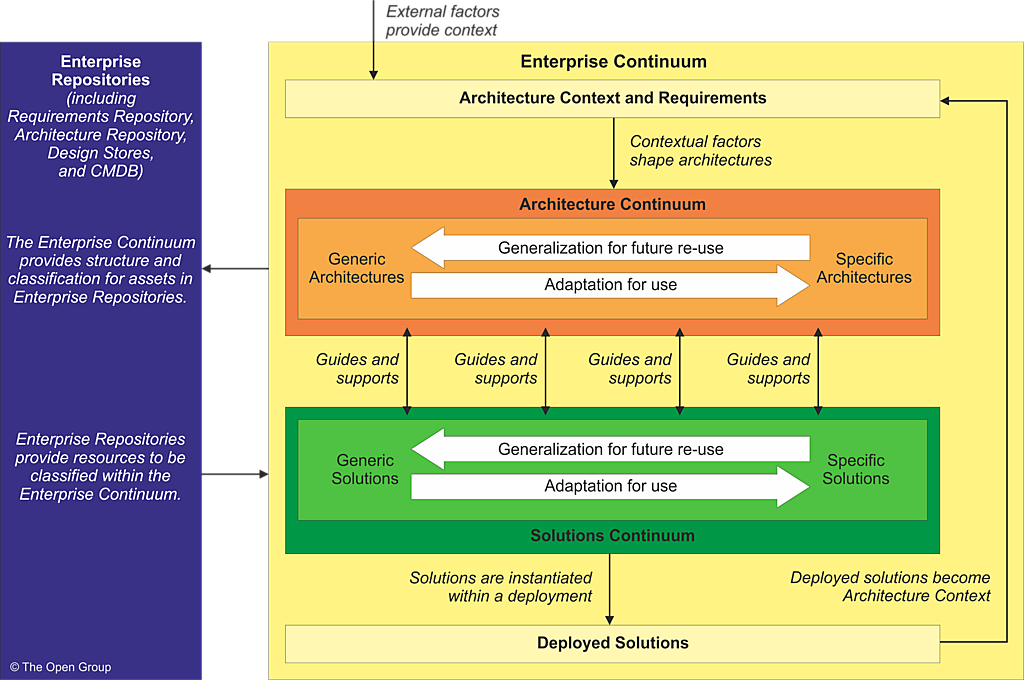
Supporting the Enterprise Continuum is the concept of an Architecture Repository which can be used to store different classes of architectural output at different levels of abstraction, created by the ADM. In this way, the TOGAF standard facilitates understanding and co-operation between stakeholders and practitioners at different levels.
By means of the Enterprise Continuum and Architecture Repository, architects are encouraged to leverage all other relevant architectural resources and assets in developing an Organization-Specific Architecture.
In this context, the TOGAF ADM can be regarded as describing a process lifecycle that operates at multiple levels within the organization, operating within a holistic governance framework and producing aligned outputs that reside in an Architecture Repository. The Enterprise Continuum provides a valuable context for understanding architectural models: it shows building blocks and their relationships to each other, and the constraints and requirements on a cycle of architecture development.
The structure of the TOGAF Architecture Repository is shown in Figure 2-4 .
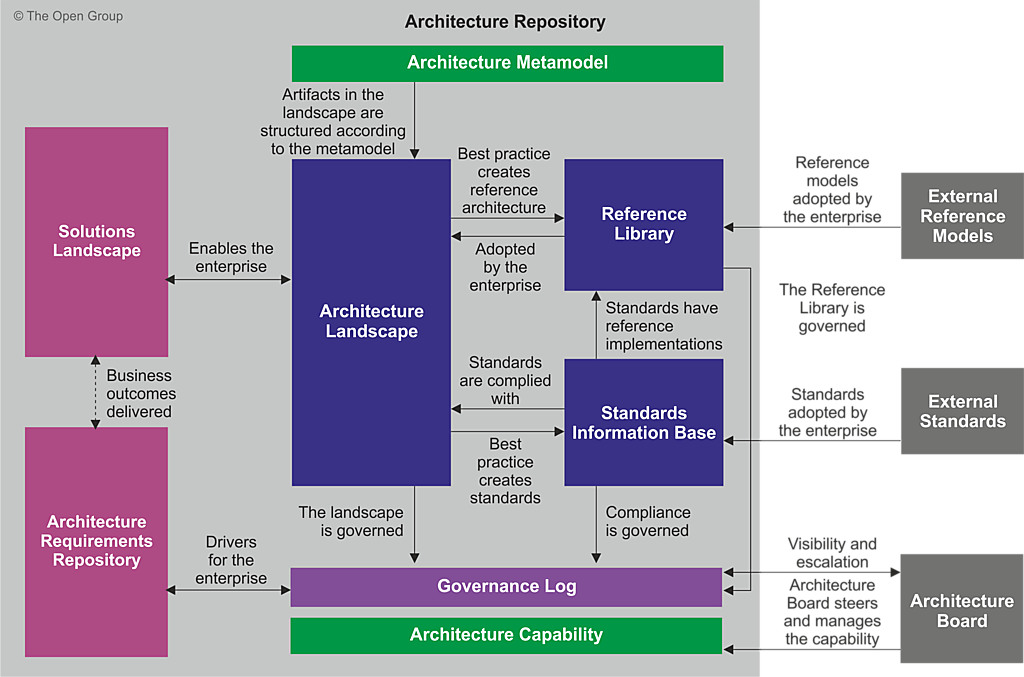
The major components within an Architecture Repository are as follows:
In order to carry out architectural activity effectively within an enterprise, it is necessary to put in place an appropriate business capability for architecture, through organization structures, roles, responsibilities, skills, and processes. An overview of the TOGAF Architecture Capability is shown in Figure 2-5 .
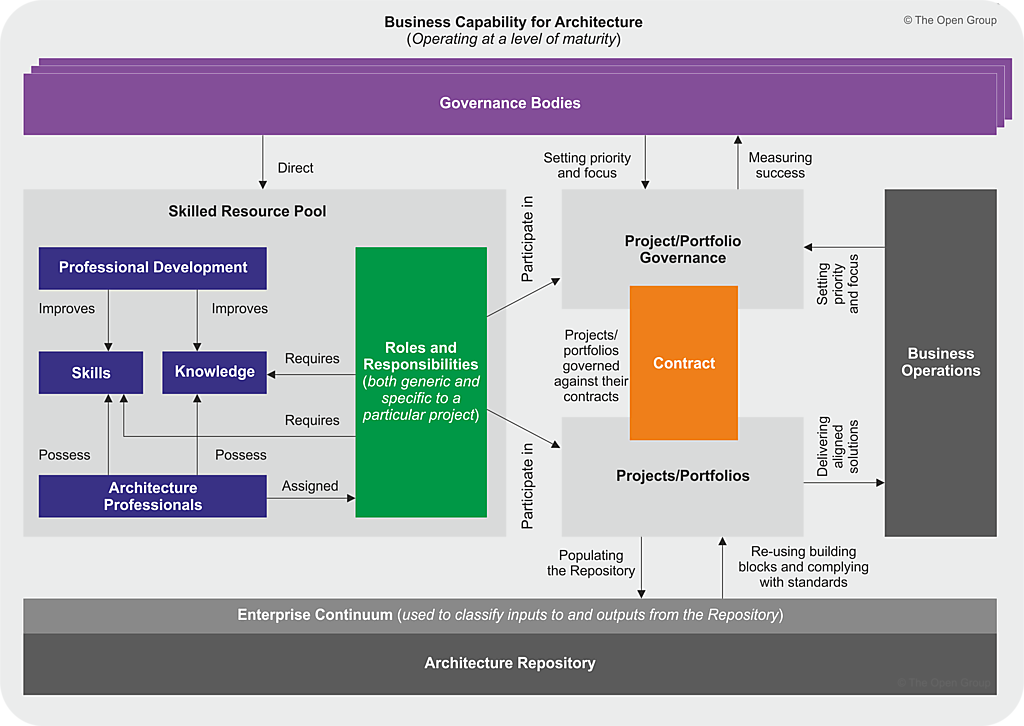
Barring Architecture Capabilities set up to purely support change delivery programs, it is increasingly recognized that a successful Enterprise Architecture practice must sit on a firm operational footing. In effect, an Enterprise Architecture practice must be run like any other operational unit within a business; i.e., it should be treated like a business. To this end, and over and above the core processes defined within the ADM, an Enterprise Architecture practice should establish capabilities in the following areas:
Central to the notion of operating an ongoing architecture is the execution of well-defined and effective governance, whereby all architecturally significant activity is controlled and aligned within a single framework.
As governance has become an increasingly visible requirement for organizational management, the inclusion of governance within the TOGAF standard aligns the framework with current business best practice and also ensures a level of visibility, guidance, and control that will support all architecture stakeholder requirements and obligations.
The benefits of Architecture Governance include:
Further detail on establishing an Enterprise Architecture Capability is given in Part VI, 39. Introduction to Part VI .
Two of the key elements of any Enterprise Architecture framework are:
With some exceptions, the majority of Enterprise Architecture frameworks focus on the first of these - the specific set of deliverables - and are relatively silent about the methods to be used to generate them (intentionally so, in some cases).
Because the TOGAF standard is a generic framework and intended to be used in a wide variety of environments, it provides a flexible and extensible content framework that underpins a set of generic architecture deliverables.
As a result, the TOGAF framework may be used either in its own right, with the generic deliverables that it describes; or else these deliverables may be replaced or extended by a more specific set, defined in any other framework that the architect considers relevant.
In all cases, it is expected that the architect will adapt and build on the TOGAF framework in order to define a tailored method that is integrated into the processes and organization structures of the enterprise. This architecture tailoring may include adopting elements from other architecture frameworks, or integrating TOGAF methods with other standard frameworks or best practices, such as ITIL®, CMMI®, COBIT®, PRINCE2®, PMBOK®, and MSP®. It may also include adopting reference materials from the TOGAF Library, such as the IT4IT™ Reference Architecture. Guidelines for adapting the TOGAF ADM in such a way are given in Part II, 4.3 Adapting the ADM .
As a generic framework and method for Enterprise Architecture, the TOGAF standard provides the capability and the collaborative
environment to integrate with other frameworks. Organizations are able to fully utilize vertical business domains, horizontal
technology areas (such as security or manageability), or application areas (such as e-Commerce) to produce a competitive Enterprise
Architecture framework which maximizes their business opportunities.
 return to top of page
return to top of page